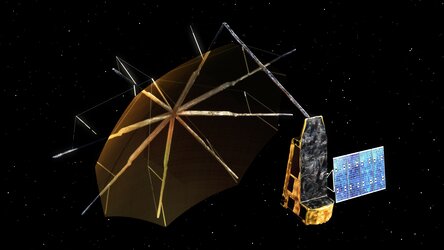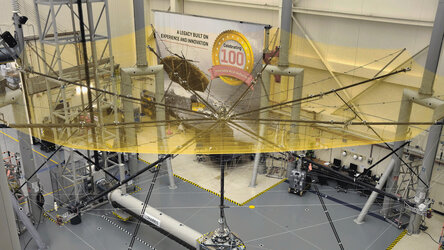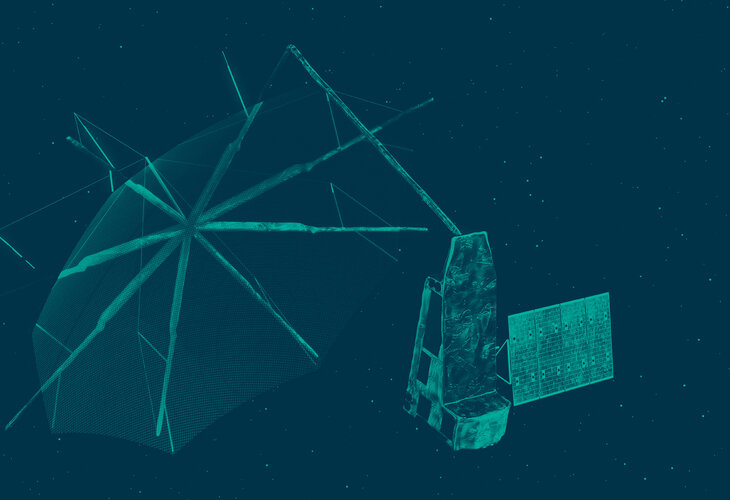Biomass heads for the shaker
Over the last six months, engineers at Airbus in Stevenage, UK, and teams from Europe and North America have turned a multitude of structural parts and electronic units into a complete satellite: ESA’s Biomass satellite. Now complete, this brand-new satellite has been shipped to Airbus’ testing facility in Toulouse, France, where it will be put through its paces to ensure that it will survive the rigours of liftoff and the harsh environment of space to deliver on its promise, that being to yield new insight into Earth’s precious forests.
Forests play a crucial role in Earth’s carbon cycle by absorbing and storing large amounts of carbon from atmosphere – therefore helping to keep our planet cool. However, as swathes of forest continue to be cleared, carbon is being released back into the atmosphere.
As we seek to slow the progress of climate change and prevent the loss of biodiversity, the health of the world’s forests is key. Knowing exactly how much carbon forests store will help understand how healthy they are and how they are changing, and will advance our knowledge of the carbon cycle.
ESA’s upcoming Biomass mission will take forest counting to a new level by using a type of instrument that has never before been flown in space: a ‘P-band’ synthetic aperture radar. P-band is the longest radar wavelength available to Earth observation.


Access the video
From 666 km above, the Biomass instrument will be able to ‘see’ through the leafy forest canopy and measure the height of the trees. This information will be used to work out how much biomass – a proxy for carbon – is being stored in forests.
Biomass is an Earth Explorer mission are developed within ESA’s world leading FutureEO programme, which harnesses novel ideas and concepts to forge pioneering satellite missions. Earth Explorer satellites carry innovative space technology to return an astonishing wealth of scientific findings about our planet, which in turn benefits society.
Scheduled to be launched in 2024, the Biomass satellite now in the last throws of being tested for liftoff and for it to join fellow Earth Explorers in orbit around Earth.

Prior to the important milestone being shipped to Airbus’ facilities in Toulouse, the Airbus team in Stevenage were busy for months on the critical task of piecing the satellite together.
ESA’s Biomass Project Manager, Michael Fehringer, said, “This was no mean feat – building a satellite is an extremely complicated and delicate undertaking. It has involved more than 80 companies from different parts of Europe along with contributions from the US and Canada.
“For example, the satellite’s huge antenna, the ‘Large Deployable Array’, was delivered in early August and integrated with the support of the team from L3Harris Technologies in Florida.
“This was closely followed by Biomass instrument arrival and its integration with the support of Airbus team from Friedrichshafen in Germany. During the integration phase, the team from OHB also joined to carry out leak tests.
“Then, to complete the satellite build, the solar array was delivered and integrated by the Airbus team from Leiden in the Netherlands. Finally, the satellite was ‘dressed’ in multilayer insulation by Beyond Gravity for the first phase of the environmental campaign, which will now be carried out in Toulouse.

“All in all, we have had several hundred experts working at peak times to get to this stage and I am very proud of what has been achieved.
“It is so rewarding to see Biomass now complete and ready for final testing, which will demonstrate that it will survive liftoff and operate as it should in the extreme environment of space.”
These tests include, for example, putting the satellite on a shaker to simulate the vibrations it will have to withstand during liftoff as well as exposing it to extreme noise and thermal tests will simulate the extreme temperature swings of space.














 Germany
Germany
 Austria
Austria
 Belgium
Belgium
 Denmark
Denmark
 Spain
Spain
 Estonia
Estonia
 Finland
Finland
 France
France
 Greece
Greece
 Hungary
Hungary
 Ireland
Ireland
 Italy
Italy
 Luxembourg
Luxembourg
 Norway
Norway
 The Netherlands
The Netherlands
 Poland
Poland
 Portugal
Portugal
 Czechia
Czechia
 Romania
Romania
 United Kingdom
United Kingdom
 Slovenia
Slovenia
 Sweden
Sweden
 Switzerland
Switzerland



































